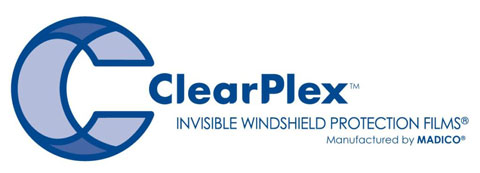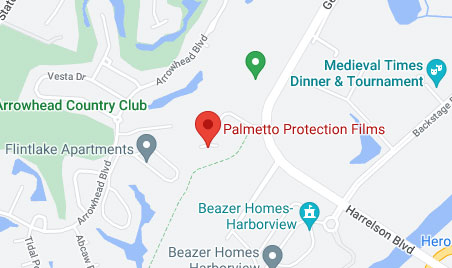CAR WINDOW TINT
We provide window tinting and film protection for all vehicle makes and models.
If you have received a citation or ticket for your window tint, we can remove your illegal window film and replace it to meet state specifications. We also remove bubbled up tint and tears.
PALMETTO PROTECTION FILMS IS THE ONLY CERTIFIED INSTALLER OF CLEARPLEX WINDSHIELD PROTECTION FILM IN THE MYRTLE BEACH AREA

Clearplex Windshield Protection Film by Madico is the world’s first and best-performing windshield protection film and the only film of its kind that has been awarded three U.S. patents.
We’re the only certified window tint specialists in the Myrtle Beach area. Our installers are certified and trained specifically on the window films we use. This ensures customers superior performance and a professional installation result.
CLEARPLEX WINDOW TINT BENEFITS
CAR WINDOW TINTING IN MYRTLE BEACH
Window Tinting
We provide window tinting and film protection for all vehicle makes and models.
Window Tint Removal
If you have received a citation or ticket for your window tint, we can remove your illegal window film and replace it to meet state specifications. We also remove bubbled up tint and tears.
ClearPlex Windshield Protection Film
Clearplex is the world’s first and best-performing windshield protection film. Optically clear, absorbs impact, scratch resistant, and protects against 99% of the sun’s harmful UV rays.
Tail Light & Side-Marker Tinting
Customize your ride with tail-light and side-marker tinting. We can modify headlights, taillights, and side markers to give your ride a personalized look.
Chrome Deletes
Palmetto Protection Film will help you cover the chrome parts of your vehicle in black satin, matte or gloss finishes.
Emblem Vinyl Wrapping
Keep your logo looking good for the life of your vehicle. We provide emblem vinyl wrapping to protect your brand and image from debris, scratches and UV fading.
LIFETIME WINDOW TINT PROTECTION GUARANTEE
Palmetto Protection Films offers a lifetime guarantee against bubbling, peeling, discoloring, or delaminating. We’ll replace the film at no cost to you.
*Lifetime Window Tint Protection Guarantee applies to the original owner when service was completed and is non-transferrable.
There's No Such Thing as the Perfect Tint Job...
All window tint is carefully applied, but due to static & floating particles, a job will never be 100% particle free or perfect. Read more from the International Window Film Association:
Architectural Visual Inspection Standard For Applied Window Film
1. Installed film on flat glass surfaces is not expected to have the same level of visual quality as glass. The following criteria apply to the installed film only and not to any defect inherent in the glass.
2. Installed film has a discrete time for full adhesion to be effected since installation utilizes a detergent solution in the water to float the film onto the glass: the excess water is squeegeed out, but inevitably residual water will remain between the film and glass. The time to achieve full adhesion is often referred to as “the adhesive cure time”. Adhesion will be increasing from a lower value during this time. Visual and adhesive cure time is related to thickness of the film and various metallic coating on the film. Typical visual cure times may be extended or shortened according to climatic conditions.
3. Inspection for optical quality can be made before full visual cure is attained. Table 1 provides a guide for typical visual cure times. It should be noted that effects during cure, such as water bubbles, water distortion, and water haze are not to be regarded as defects.
4. The glass with applied film shall be viewed at right angles to the glass from the room side, at a distance of not less than 6 feet (2 meters). Viewing shall be carried out in natural daylight, not in direct sunlight, and shall assess the normal vision area with the exception of a 2 inch (50mm) wide band around the perimeter of the unit.
5. The installation shall be deemed acceptable if all of the following are unobtrusive (effects during visual cure should be disregarded): Dirt Particles, Hair and Fibers, Adhesive Gels, Fingerprints, Air Bubbles, Water Haze, Scores and Scratches, Film Distortion, Creases, Edge Lift, Nicks and Tears. Inspection may by made within 1 day of installation. Obtrusiveness of blemishes shall be judged by looking through the film installation under lighting conditions described in 4.
6. The 2 inch (50mm) wide band around the perimeter shall be assessed by a similar procedure to that in 3 and 4, but a small number of particles is considered acceptable where poor frame condition mitigates against the high quality standards normally achieved.
7. Edge gaps will normally be 1/32 – 1/16 inch (1-4mm). This allows for the water used in the installation to be squeegeed out. This ensures that film edges are not raised up by contact with the frame margin. Contact with the frame margin could lead to peeling of the film.
8. For thicker safety films the edge gaps will normally be 1/32 – 1/16 inch (1-4mm), with 1/32 – 1/8 inch (1-5mm) being acceptable for films of (7 mil (175)). Combination solar control safety films will also fall within this standard. An edge gap of up to 1/16 inch (2mm) is recommended, especially for darker (tinted, metallized, tinted/metallized, and sputtered) films, to minimize the light line around the edge of the installed film.
9. Splicing of films is necessary when larger panels of glass are treated, where both length and width of the glass exceed the maximum width of film. The splice line itself should not be viewed as a defect. This line should be straight and should be parallel to one edge of the frame margin. The two pieces of film may be butt jointed. The maximum gap at any point in the splice line should be 1/64 inch (1mm). Film may be overlapped, spliced or butt jointed.
10. Certain films with special high performance coating may have lengthened cure times. Consult the manufacturer for cure times of these films.
Table 1 – Typical Cure Times
Film thickness in mils Film thickness in microns(µ) Typical Cure Time (days)
Up to 4 Up to 100 30
4 to 8 100 to 200 60
8 to 12 200 to 300 90
Over 12 but not more than 17 Over 300 but not more than 425 140
*Special adaptation of information received from the Glass and Glazing Federation; reproduced with their permission.
Copyright© International Window Film Association | All Rights Reserved
Architectural Visual Inspection Standard For Applied Window Film
1. Installed film on flat glass surfaces is not expected to have the same level of visual quality as glass. The following criteria apply to the installed film only and not to any defect inherent in the glass.
2. Installed film has a discrete time for full adhesion to be effected since installation utilizes a detergent solution in the water to float the film onto the glass: the excess water is squeegeed out, but inevitably residual water will remain between the film and glass. The time to achieve full adhesion is often referred to as “the adhesive cure time”. Adhesion will be increasing from a lower value during this time. Visual and adhesive cure time is related to thickness of the film and various metallic coating on the film. Typical visual cure times may be extended or shortened according to climatic conditions.
3. Inspection for optical quality can be made before full visual cure is attained. Table 1 provides a guide for typical visual cure times. It should be noted that effects during cure, such as water bubbles, water distortion, and water haze are not to be regarded as defects.
4. The glass with applied film shall be viewed at right angles to the glass from the room side, at a distance of not less than 6 feet (2 meters). Viewing shall be carried out in natural daylight, not in direct sunlight, and shall assess the normal vision area with the exception of a 2 inch (50mm) wide band around the perimeter of the unit.
5. The installation shall be deemed acceptable if all of the following are unobtrusive (effects during visual cure should be disregarded): Dirt Particles, Hair and Fibers, Adhesive Gels, Fingerprints, Air Bubbles, Water Haze, Scores and Scratches, Film Distortion, Creases, Edge Lift, Nicks and Tears. Inspection may by made within 1 day of installation. Obtrusiveness of blemishes shall be judged by looking through the film installation under lighting conditions described in 4.
6. The 2 inch (50mm) wide band around the perimeter shall be assessed by a similar procedure to that in 3 and 4, but a small number of particles is considered acceptable where poor frame condition mitigates against the high quality standards normally achieved.
7. Edge gaps will normally be 1/32 – 1/16 inch (1-4mm). This allows for the water used in the installation to be squeegeed out. This ensures that film edges are not raised up by contact with the frame margin. Contact with the frame margin could lead to peeling of the film.
8. For thicker safety films the edge gaps will normally be 1/32 – 1/16 inch (1-4mm), with 1/32 – 1/8 inch (1-5mm) being acceptable for films of (7 mil (175)). Combination solar control safety films will also fall within this standard. An edge gap of up to 1/16 inch (2mm) is recommended, especially for darker (tinted, metallized, tinted/metallized, and sputtered) films, to minimize the light line around the edge of the installed film.
9. Splicing of films is necessary when larger panels of glass are treated, where both length and width of the glass exceed the maximum width of film. The splice line itself should not be viewed as a defect. This line should be straight and should be parallel to one edge of the frame margin. The two pieces of film may be butt jointed. The maximum gap at any point in the splice line should be 1/64 inch (1mm). Film may be overlapped, spliced or butt jointed.
10. Certain films with special high performance coating may have lengthened cure times. Consult the manufacturer for cure times of these films.
Table 1 – Typical Cure Times
Film thickness in mils Film thickness in microns(µ) Typical Cure Time (days)
Up to 4 Up to 100 30
4 to 8 100 to 200 60
8 to 12 200 to 300 90
Over 12 but not more than 17 Over 300 but not more than 425 140
*Special adaptation of information received from the Glass and Glazing Federation; reproduced with their permission.
Copyright© International Window Film Association | All Rights Reserved
WHAT FOLKS ARE SAYING ABOUT OUR CAR WINDOW TINT IN MYRTLE BEACH…
“This is the third vehicle that Palmetto Protection Films has installed window tinting on for my family vehicles. The workmanship, price, and customer service is excellent. Kristy in the office is exceptional in communication and always returns calls in a timely fashion. I live in central NC and take my vehicles to Palmetto in SC because they do such an excellent job.”
“I can’t thank Matt enough! He did an awesome job tinting my truck. It turned out great and the pricing was the best around. I highly recommend Palmetto Protection Films to anyone wanting to get their home or vehicle tinted.”
“It’s as if I have a brand new car!! Love the look. Casey arrived on time! Professional. Very personable. Did an excellent job. Highly recommend.”

